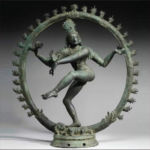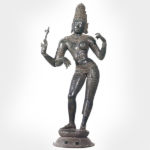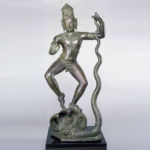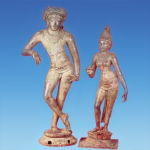Architecture and Literature
During the period of 1st to 9th Century AD, the Chera, Chola, Pandya and Pallava rulers ruled the region of present day Tamilnadu. The early Cholas ruled between 1st to 4th Century after which the Pallavas rose to prominence. But internal feud led them to a gradual decline and finally defeated by Aditya Chola in the 9th Century AD.
Empire of the 11th century
The Chola Empire extended its boundaries up to Orissa and parts of West Bengal in the north and to Ceylon in the south by defeating the Pandyas. By the end of 11th century AD, Chalukyas- another famous dynasty of south India- rose into prominence together with the Cholas, but couldn’t stand the mighty Chola kingdom for long time. Eventually, Cholas became prominent and ruled Tamil Nadu till the end of the 13th century AD. The golden period under the Cholas was during the rule of King Rajaraja (985-1014 AD) and his son Rajendra Chola (1012-1044 AD).
Temple Architecture
Monumental structures of temples with astounding sculptural excellence came up during this period. The temple structures of Tanjavur, Chidambaram, Gangai konda Cholapuram, Darasuram, Tribhuvanam, Sri Rangam and Tiruvannamalai were developed during this period. Out of these, the Brihadiswara temple of Tanjavur and Airavateswara temple of Darasuram have been declared as world heritage monuments by the UNESCO and the citation reads, “an outstanding creative achievement in the architectural conception of the pure form of the Dravida type temple” and “the most outstanding testimony to the development of the architecture of the Chola empire and Tamil civilization in Southern India.
Scholars have observed a continuous growth and maturity of the temple structures during the Chola period. Compared with the cave and rock-cut structures of the Pallava period, the early Chola temples had extended corridors and then, small shrines for parivaara devatas. The parivaara shrines, usually eight in number, were meant for attendant deities like Ganesa, Subrahmanya, Surya, Candra, Saptamatrkas, Jyestha, Candikesvara and Nandi. The gopuras of this period continue to be inconspicuous, the vimãnas, dominating the temple complex. The temple walls had niches in which were carved Ganesha, Durga, Lingothbhava, Dakshinamurthy, Brahma, Nataraja, Bikshadana, Ardhanariswara and Agastya.
Later, towering gopurams, intricate sculptures and huge walls were the specialties. The basement had ornamented pilasters and more number of niches. The parivara shrines were also multiplied and separate shrines for Devi were built. Next, storeyed gopuras and pillared mandapas were built.
The two magnificent temples at Tanjore and Gangaikonda Cholapuram in Tiruchirapalli District built in early 11th century A.D. show the best of Chola art.
The Brihadeswara or Rajarajeswara Temple of Shiva in Tanjore built by Rajaraja Chola in 1010 A.D. is the largest and highest of Chola temples and stands as a symbol of Chola greatness. The gopuram on the entrance gates are decorated with beautiful sculptures. The temple stands in a spacious enclosed courtyard and pavilion with one of the largest monolithic Nandis (6 metres long, 2.6 metres broad and 307 metres high) in South India, a large assembly hall and a pillared portico. (It shall be noted that this Nandi that stands there in the temple today, is a contribution of the later kings, probably the Nayaks, while the Cholas originally had a smaller nandi when the temple was completed)
The hundred and eight dance poses of Shiva carved on the inner walls of this temple testify to the heights attained by the Cholas in the field of sculpture and Natya. The 108 karanas mentioned in the Natyasastra are found sculpted in the 1st storey in the sanctum sanctorum. They are in even size at eye level, and in their chronological order from 1 to 81. Even though there are measured blocks for the remaining karanas, the mystery of them being undone, is yet unsolved.
The temple of Shiva at Gangaikonda Cholapuram built by Rajendra Chola (1018 to 1033 A.D.) is another master piece of temple architecture. A new development was the addition of a gateway or gopuram to the walled enclosure of the temple.
Literature
Literary works that came up during this period are
- Jain works like Jivakacintamani, Perungkathai
- Periyapuranam, Kambaramayanam and works of Ottakkooththar, Avvayaar
- Beginning of prabanda literature like parani (Koodal-sangamaththu-parani, Koppaththu-parani), Pillaiththamizh
- Grammar works like Amirthasagarar’s Yapperungalam and Amrita Saagarar’s Yaapperungalak kaarigai.
- Distinctive philosophy of Saiva Siddhantha was evolved
- The Saiva canonical poems composed by 63 leading saints scanning approximately 600 years were classified into 12 books called ‘Tirumurai’, by Nambi aandaar nimbi according to the wishes of King Abhaya Kulasekharan
- Saiva Agamas were also made
- Other works made during the 11th century were Kallaadam, Kuloth-thunga Sozhan saridai, Ponnaiyyan Kanna nool.
- The notable features in this time: Philosophical ideas, religious principles – with equality of spiritual democracy irrespective of caste and creed, simple style of poetry, stress of ethical values and virtues.






